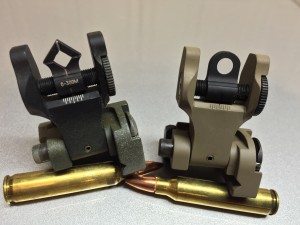 Four or five years ago I decided to ditch my A2 carry handle and put a Troy BUIS on my AR. Being new to the AR platform, I thought it would be a good idea to purchase the Troy BUIS with the Di-Optic Aperture (DOA) instead of a standard A2 aperture. Fast forward to 2015 and I have put enough rounds down range comparing the two apertures that I feel confident in offering an experience based opinion.
Four or five years ago I decided to ditch my A2 carry handle and put a Troy BUIS on my AR. Being new to the AR platform, I thought it would be a good idea to purchase the Troy BUIS with the Di-Optic Aperture (DOA) instead of a standard A2 aperture. Fast forward to 2015 and I have put enough rounds down range comparing the two apertures that I feel confident in offering an experience based opinion.
Yes, I know Troy Industries has made a lot of people mad with the hiring and appointment of individuals with polarizing backgrounds, but they still make a good product. I’ve found many of the people who say they’ll never send another dime to Troy are often the same ones that don’t bat an eye purchasing crap made in China by an oppressed people under a communist regime.
What is the Di-Optic Aperture? I’ll let Troy Industries explain:
“The DOA™ key design strength lies in its rhombus-shaped aperture, which centers the eye on the front post instantly and effortlessly. In a heartbeat, the shooter zeroes on the target and is ready to fire. Circular apertures simply cannot produce this effect. The DOA™ optics, coupled with Troy Industries™ legendary battle-ready toughness, provides a dramatic advance in shooting speed, accuracy and reliability.”
Sold! I can safely say, after shooting a standard A2 carry handle and the DOA side by side, that my eyes prefer the standard A2 Aperture. As for ruggedness and quality, the Troy BUIS is solid as a rock and works as advertised.
I had two main issues with the DOA, issues that were also noticed by some friends that shot my gun with the DOA sight installed.
- The white lines are visible and rather distracting when you bring the gun up and look through the sight. I am not sure the purpose and I used a Sharpie to darken them, which helped, but…
- I found the diamond shape to be completely distracting. The human eye is really good at centering the object in focus and for my eyes the round aperture of the A2 style sight just “melts” away, leaving a clear front post view. With the DOA, I couldn’t get that Diamond shape out of my peripheral vision; as a result I found myself chasing the front post with each shot. It actually had the opposite effect! It made me slower and less accurate; which is not something I look for in a sight.
In a nutshell, the Di-Optic Aperture made it harder for me to make accurate shots and I damn sure wasn’t any quicker on a timer. I can solidly recommend the Troy BUIS for their durability, but in my opinion, stay with the standard A2 aperture and your training time and money can be used to improve other skills, instead of learning a new sight system.
As for me, I am selling the Di-Optic and sticking with the A2 unit in the photo.
Oh, oh, oh. Do XS Big Dots next!
First I’d have to by them and try them. No.
What’s interesting is I had the complete opposite experience with these sights. I love them, and they absolutely work great for me. I wouldn’t hesitate to recommend them to someone looking for a BUIS.
My buddy has the Di-Optics with a Troy Alpha rail and the integrated front sight. I hated them. The front sight ears are also diamond shaped, and i found myself trying to align the diamonds, rather than centering the post.
I’ve tried all the ones discussed here, and I prefer the standard A2 by far, then the Di-optics, and the XS Big dot last. Don’t know why exactly, the A2s just work the best for me it seems (easiest and quickest to aquire and align). But…..on my pistols, I love XS Big Dots. So go figure…
I prefer the round aperture
with a the HK style round front wings. To me, it is like aligning a circle in a circle and is quite fast. With the standard front sight, I slow down to make sure I get the front post centered. Especially for long shots.
I have the same problem w/ the HK style sights and a round aperture as I do with the diamond-diamond: I align the external shapes, rather than the post to the rear sight. Sure, it’s great if the post is in the horizontal center of the front wings, but if it’s not, the wings are visual noise.
I tried the Troy Di-optic and found the same issues as you did. I found that XS Sight Systems sells a replacement rear aperture that not inly brings back the circle but adds a feature. Worth a look. I like it a lot.
http://www.xssights.com/Detail.aspx?PROD=993121&CAT=8276
I actually looked into that, but it had mixed reviews and it is designed for a 100 meter zero, while I prefer the 50/200 meter zero. I didn’t want to buy another sight that might wind up sold or tossed.